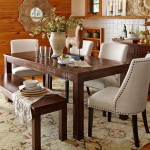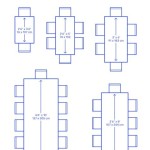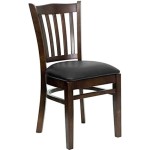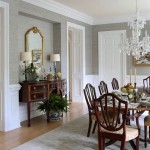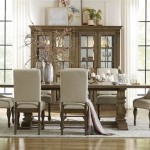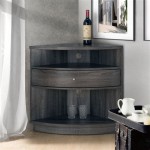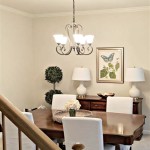Dining Room Sets for Small Areas: Maximizing Space and Style
The modern living environment often presents challenges in accommodating all desired functionalities within limited square footage. The dining room, traditionally a central gathering space, may require adaptation to fit smaller apartments, condos, or homes. Selecting the appropriate dining room set for a small area is crucial not only for functionality but also for maintaining aesthetic appeal and flow within the living space. This article will explore the key considerations, types of furniture, and design strategies for choosing a dining room set that effectively utilizes space while maintaining a comfortable and stylish dining environment.
The primary objective when furnishing a small dining area is to maximize usable space without sacrificing comfort or visual appeal. This involves a careful assessment of the available dimensions, the intended use of the space, and the aesthetic preferences of the homeowner. A well-chosen dining set can transform a cramped corner into a functional and inviting area for meals, work, or socializing. Conversely, an ill-suited set can exacerbate a sense of confinement and clutter.
Key Considerations Before Purchasing
Before committing to a specific dining room set, it is essential to conduct a thorough assessment of the space and its intended function. This includes measuring the dimensions of the dining area, considering the number of people who will typically use the space, and evaluating the existing decor to ensure a cohesive aesthetic.
Space Measurement: Accurate measurements are the foundation of successful small space design. Measure the length and width of the designated dining area, paying attention to any obstructions such as doorways, radiators, or built-in features. It is also important to consider the clearance required around the table and chairs to allow for comfortable movement. A general guideline is to allow a minimum of 36 inches of space between the edge of the table and any wall or obstacle. This ensures that individuals can easily pull out chairs and move around the table without bumping into objects.
Seating Needs: The number of regular users significantly impacts the appropriate size and style of the dining set. For individuals or couples, a small round or square table with two chairs may suffice. For small families or those who frequently entertain, a rectangular table with four chairs or a drop-leaf table that can be expanded for larger gatherings may be more suitable. Consider the frequency with which extra seating is required. If it is infrequent, folding chairs or stools can be stored and brought out as needed, minimizing the impact on daily space usage.
Existing Decor: The new dining set should complement the existing decor of the surrounding area. Consider the color scheme, architectural style, and overall aesthetic of the room. A modern apartment might benefit from a sleek, minimalist dining set with clean lines and neutral colors, while a more traditional home could accommodate a set with richer colors and more ornate details. Maintaining a cohesive style throughout the space creates a unified and harmonious look.
Types of Dining Room Sets Suitable for Small Spaces
Several types of dining room sets are particularly well-suited for small spaces. These include round tables, square tables, drop-leaf tables, and nesting sets. Each offers unique advantages and disadvantages in terms of space utilization, seating capacity, and aesthetic appeal.
Round Tables: Round tables are often an excellent choice for small areas due to their space-saving design and ability to promote conversation. The absence of corners allows for easier movement around the table and can create a more intimate dining experience. Round tables are particularly effective in square rooms, where they can soften the angles and create a more balanced visual appearance. However, round tables can be less efficient for accommodating large groups, as the seating capacity is limited by the table’s diameter.
Square Tables: Similar to round tables, square tables offer a compact footprint that is ideal for small spaces. They work well in both square and rectangular rooms and can be pushed against a wall when not in use to further maximize space. Square tables are typically available in sizes that comfortably seat two or four people, making them a practical choice for small families or couples. The angular shape can also provide a more structured and modern aesthetic.
Drop-Leaf Tables: Drop-leaf tables offer the flexibility of a small table that can be expanded to accommodate larger gatherings. These tables feature one or more leaves that can be folded down when not needed, reducing the table’s footprint. When extra seating is required, the leaves can be raised to create a larger dining surface. Drop-leaf tables are particularly useful for individuals who live in small apartments but occasionally host dinner parties or family gatherings. They provide the convenience of a larger table without permanently occupying valuable floor space.
Nesting Sets: Nesting dining sets typically consist of a table with multiple chairs that can be stored underneath the table when not in use. This design is exceptionally space-saving, making it ideal for very small apartments or studios where every square inch counts. Nesting sets are often minimalist in design, focusing on functionality and compactness. While they may not offer the same level of comfort or aesthetic appeal as traditional dining sets, they provide a practical solution for maximizing space in extremely limited environments.
Design Strategies for Optimizing Small Dining Areas
Beyond the selection of the right dining room set, several design strategies can further enhance the functionality and visual appeal of a small dining area. These include the use of light colors, strategic lighting, mirrors, and multi-functional furniture.
Light Colors: Light colors, such as white, cream, and pastel shades, can create a sense of spaciousness and airiness in a small room. These colors reflect light, making the room appear larger and brighter. When selecting a dining set for a small area, consider options with light-colored finishes or upholstery. Light-colored walls and flooring can further enhance the effect, creating a cohesive and open environment. Avoid dark or overly saturated colors, as they can absorb light and make the room feel smaller and more enclosed.
Strategic Lighting: Proper lighting is essential for creating a welcoming and functional dining area. In small spaces, it is particularly important to maximize natural light whenever possible. Keep windows unobstructed and consider using sheer curtains to allow light to filter through while maintaining privacy. Supplement natural light with artificial lighting, such as overhead fixtures, pendant lights, or table lamps. A well-placed pendant light above the dining table can create a focal point and define the dining area. Layering different types of lighting can also add depth and dimension to the space.
Mirrors: Mirrors are a powerful tool for creating the illusion of more space. Strategically placed mirrors can reflect light and visually double the size of the room. Consider hanging a large mirror on a wall opposite a window to maximize the amount of light reflected into the room. Alternatively, a smaller decorative mirror can be used as a focal point on a blank wall. When placing mirrors, be mindful of what they reflect. Avoid reflecting clutter or unsightly areas, as this can detract from the overall aesthetic.
Multi-Functional Furniture: Multi-functional furniture is a valuable asset in small living spaces. Consider incorporating pieces that serve multiple purposes, such as a dining table with built-in storage or chairs that can be easily stacked or folded away when not in use. A console table or sideboard can provide additional storage space for dishes, linens, or other dining essentials. When selecting multi-functional furniture, prioritize pieces that are both practical and aesthetically pleasing, ensuring that they complement the overall design of the dining area.
Vertical Space Utilization: In small rooms, utilizing vertical space is crucial for maximizing storage and minimizing clutter. Shelving units, wall-mounted cabinets, and tall storage pieces can provide ample storage without taking up valuable floor space. Consider installing shelves above the dining table to display decorative items, store books, or hold dishes. Wall-mounted cabinets can be used to store linens, silverware, or other dining essentials. By utilizing vertical space, you can keep the dining area organized and clutter-free, creating a more spacious and inviting environment.
Choosing the right dining room set for a small area requires careful consideration of space, seating needs, and aesthetic preferences. By selecting furniture that is appropriately sized and styled for the space, and by employing effective design strategies, it is possible to create a functional and stylish dining area that enhances the overall living environment.

Incorporating A Dining Table Set Into Small Space Here S How Laura James

Small Dining Table Ideas Space Saving Furniture Design 2024

Maximize Your Space Innovative Small Dining Room Ideas For Apartments Oppein

Best Dining Sets For Small Spaces Furniture Outlet Blog

Space Saving Round Shape 4 Seater Dining Table Se

Small Space Dining Ideas That Maximize Every Inch

1000mm Round Wooden Nesting Dining Table Set For 4 Green Upholstered Chairs Homary

Four Seater Dining Set

15 Unique Small Dining Room Ideas For Spaces

How To Set Up A Small Dining Room Temple Webster

